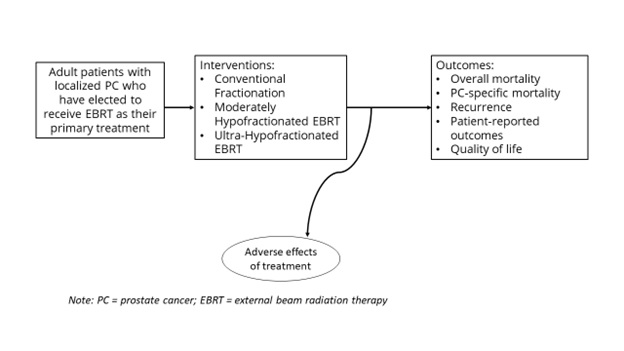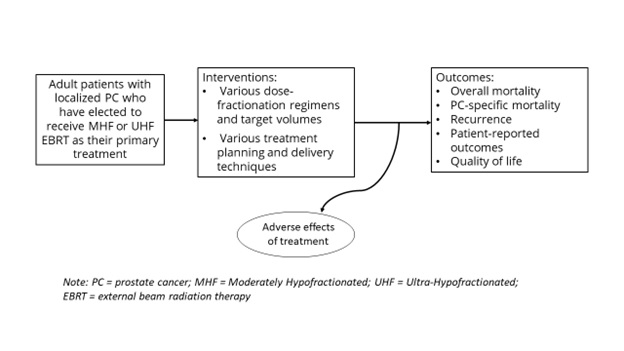One in eight men in the United States will develop prostate cancer in his lifetime1; prostate cancer is the leading type of cancer among men (age-adjusted incidence rate of 113.4/100,000 men between 2016 and 2020) and the second leading cause of cancer-related death (age-adjusted mortality rate of 18.8/100,000 men between 2016 and 2020)2. Seventy percent of prostate cancer diagnoses are localized disease for which external beam radiation therapy (EBRT) is a definitive and frequently used therapy3,4.
Optimal EBRT treatment regimens with more aggressive fractionation size and dose, which may be less burdensome for patients and less resource intensive for healthcare systems,5,6 are being investigated. These treatment regimens include conventional fractionation, defined as 1.8–2.0 Gy per fraction, moderate hypofractionation, 2.4–3.4 Gy per fraction, and ultra-hypofractionation, ≥5.0 Gy per fraction. Moderate and ultra-hypofractionation schedules include fewer but higher dose fractions and shorter overall treatment durations than conventional fractionation. Stereotactic body radiation therapy (SBRT), also known as stereotactic ablative radiotherapy (SABR), is a form of ultra-hypofractionation that uses highly precise delivery techniques, advanced imaging, steep radiation dose gradients outside the prostate.
In their 2018 clinical practice guideline, ASTRO/ASCO/AUA issued “strong” recommendations for offering moderately hypofractionated radiation therapy to patients, noting some concerns about acute gastrointestinal toxicity and lack of long-term toxicity data. “Conditional” recommendations were offered for ultra-hypofractionated radiation therapy5. A recent Department of Veterans Affairs (VA) systematic review and guidance concluded that hypofractionation results in little to no difference in overall survival (high strength of evidence (SoE)), prostate cancer-specific survival (moderate SoE), biochemical recurrence-free survival (low SoE), acute or late gastrointestinal toxicity (moderate SoE), or acute or late genitourinary toxicity (moderate SoE) compared to conventional fractionation; however, the review did not present findings for moderate hypofractionation separately from ultra-hypofractionation6.
Important new evidence on hypofractionated radiation therapy for prostate cancer has accumulated since the VA report and more is anticipated in 20247-14: the ten-year follow up results for CHHiP, a large trial assessing moderate hypofractionation compared to conventional fractionation7, and initial effectiveness results for PACE-B, the largest trial to evaluate SBRT compared to conventional fractionation/moderately hypofractionated radiotherapy8. Findings from the largest trial to compare ultra-hypofractionation with conventional fractionation (HYPO-RT-PC) have also been reported since publication of the previous guideline.15 Consequently, a new systematic review will be timely for ASTRO to update its clinical practice statement, which intends to provide guidance for moderate hypofractionation separate from ultra-hypofractionation5. Additionally, new data on dose fractionation regimens, target volumes, treatment delivery, patient reported outcomes and quality of life may augment the guidance.
KQ1. For patients with localized prostate cancer receiving EBRT with curative intent, what are the benefits and harms of moderate hypofractionation compared to conventional fractionation?
KQ1A. Do findings vary with respect to patient characteristics (e.g. age, race and ethnicity), pretreatment characteristics (e.g., risk group, prostate gland volume, lower urinary tract symptoms), and use of adjunctive therapies (e.g., androgen deprivation therapy)?
KQ2. For patients with localized prostate cancer receiving EBRT with curative intent, what are the benefits and harms of ultra-hypofractionation compared to moderate hypofractionation or conventional fractionation?
KQ2A. Do findings vary with respect to patient characteristics (e.g. age, race and ethnicity), pretreatment characteristics (e.g., risk group, prostate gland volume, lower urinary tract symptoms), and use of adjunctive therapies (e.g., androgen deprivation therapy)?
KQ3. For patients with localized prostate cancer receiving hypofractionated EBRT with curative intent, what are the benefits and harms of different dose-fractionation regimens and target volumes (e.g., prostate, seminal vesicles, pelvic lymph nodes, focal intraprostatic boosts)?
KQ4. For patients with localized prostate cancer receiving hypofractionated EBRT with curative intent, what are the benefits and harms of different treatment planning and delivery techniques?
Contextual Question: Does utilization of EBRT type (conventional fractionation, moderate hypofractionation, and ultra-hypofractionation) differ by factors such as age, race, ethnicity, socioeconomic status, or geography?
Draft Analytic Framework
Figure 1. Preliminary Analytic Framework for Key Questions 1 & 2

Figure 2. Preliminary Analytic Framework for Key Questions 3 & 4

Table 1. PICOTSS (population, interventions, comparators, outcomes, timing, settings, study design) for KQ1-4
| KQ1 | KQ2 | KQ3 | KQ4 | |
|---|---|---|---|---|
| Population | For KQ1-2: Adult patients with localized prostate cancer who have elected to receive EBRT as their primary treatment regardless of pretreatment characteristics
KQ1a and KQ2a: Consider patient characteristics (e.g. age, race and ethnicity), pretreatment characteristics (e.g., risk group, prostate gland volume, lower urinary tract symptoms), use of adjunctive therapies (e.g., androgen deprivation therapy)
| For KQ3-4: Adult patients with localized prostate cancer who have elected to receive MHF or UHF as their primary treatment regardless of pretreatment characteristics
| ||
| Intervention | MHF
| UHF | Various dose-fractionation regimens and target volumes (e.g., prostate, seminal, vesicles, pelvic lymph nodes, focal intraprostatic boosts) | Various treatment planning and delivery techniques
|
| Comparator | CF
|
| Dose-fractionation regimens compared to each other; target volumes compared to each other [all grouped by type of hypofractionation (MHF/UHF)] | Treatment planning and delivery techniques compared to each other |
| Outcomes | For KQ 1-4: overall and prostate cancer-specific survival, local recurrence, metastases, biochemical recurrence-free survival, acute and late gastrointestinal toxicity, acute and late genitourinary toxicity, patient reported outcomes and quality of life | |||
| Timing | For all KQ: any timing | |||
| Study Design | RCT | RCT | RCT, prospective designs if RCT evidence is sparse | RCT, prospective designs if RCT evidence is sparse |
| Settings | For all KQ: all settings | |||
CF = Conventionally fractionated EBRT; MHF = moderately hypofractionated EBRT; UHF = ultra-hypofractionated EBRT; 3D-CRT=three-dimensional conformal radiation therapy; IMRT = intensity modulated radiation therapy; VMAT = volumetric modulated arc therapy; SBRT = stereotactic body radiation therapy; OARs = organs at risk
- American Cancer Society. Key statistics for prostate cancer. Accessed December 19, 2023. https://www.cancer.org/cancer/prostate-cancer/about/key-statistics.
- Cancer Stat Facts: Prostate Cancer. National Cancer Institute Surveillance, Epidemiology, and End Results Program. Accessed December 19, 2023. https://seer.cancer.gov/statfacts/html/prost.html.
- Hamdy FC, Donovan JL, Lane JA, Metcalfe C, Davis M, Turner EL, Martin RM, Young GJ, Walsh EI, Bryant RJ, Bollina P, Doble A, Doherty A, Gillatt D, Gnanapragasam V, Hughes O, Kockelbergh R, Kynaston H, Paul A, Paez E, Powell P, Rosario DJ, Rowe E, Mason M, Catto JWF, Peters TJ, Oxley J, Williams NJ, Staffurth J, Neal DE; ProtecT Study Group. Fifteen-Year Outcomes after Monitoring, Surgery, or Radiotherapy for Prostate Cancer. N Engl J Med. 2023 Apr 27;388(17):1547-1558. doi: 10.1056/NEJMoa2214122. Epub 2023 Mar 11. PMID: 36912538.
- Wilt TJ, Ullman KE, Linskens EJ, MacDonald R, Brasure M, Ester E, Nelson VA, Saha J, Sultan S, Dahm P. Therapies for Clinically Localized Prostate Cancer: A Comparative Effectiveness Review. J Urol. 2021 Apr;205(4):967-976. doi: 10.1097/JU.0000000000001578. Epub 2020 Dec 22. PMID: 33350857.
- Morgan SC, Hoffman K, Loblaw DA, Buyyounouski MK, Patton C, Barocas D, Bentzen S, Chang M, Efstathiou J, Greany P, Halvorsen P, Koontz BF, Lawton C, Leyrer CM, Lin D, Ray M, Sandler H. Hypofractionated Radiation Therapy for Localized Prostate Cancer: Executive Summary of an ASTRO, ASCO and AUA Evidence-Based Guideline. J Urol. 2019 Mar;201(3):528-534. doi: 10.1097/JU.0000000000000071. PMID: 30759696.
- Landsteiner A, Sowerby C, Ullman K, et al. Hypofractionation Radiation Therapy for Definitive Treatment of Selected Cancers: A Systematic Review. Washington, DC: Evidence Synthesis Program, Health Services Research and Development Service, Office of Research and Development, Department of Veterans Affairs. VA ESP Project 09-009; 2023.
- Syndikus I, Griffin C, Philipps L, Tree A, Khoo V, Birtle AJ, Choudhury A, Ferguson C, O'Sullivan JM, Panades M, Rimmer YL, Scrase CD, Staffurth J, Cruickshank C, Hassan S, Pugh J, Dearnaley DP, Hall E; 10-Year efficacy and co-morbidity outcomes of a phase III randomised trial of conventional vs. hypofractionated high dose intensity modulated radiotherapy for prostate cancer (CHHiP; CRUK/06/016). Journal of Clinical Oncology 2023 41:6_suppl, 304
- Tree AC, Ostler P, van der Voet H, Chu W, Loblaw A, Ford D, Tolan S, Jain S, Martin A, Staffurth J, Armstrong J, Camilleri P, Kancherla K, Frew J, Chan A, Dayes IS, Duffton A, Brand DH, Henderson D, Morrison K, Brown S, Pugh J, Burnett S, Mahmud M, Hinder V, Naismith O, Hall E, van As N; PACE Trial Investigators. Intensity-modulated radiotherapy versus stereotactic body radiotherapy for prostate cancer (PACE-B): 2-year toxicity results from an open-label, randomised, phase 3, non-inferiority trial. Lancet Oncol. 2022 Oct;23(10):1308-1320. doi: 10.1016/S1470-2045(22)00517-4. Epub 2022 Sep 13. Erratum in: Lancet Oncol. 2023 May;24(5):e192. PMID: 36113498.
- Sinzabakira F, Heemsbergen WD, Pos FJ, Incrocci L. Patient-Reported Outcomes in the Acute Phase of the Randomized Hypofractionated Irradiation for Prostate Cancer (HYPRO) Trial. Int J Radiat Oncol Biol Phys. 2022 Mar 15;112(4):870-879. doi: 10.1016/j.ijrobp.2021.10.139. Epub 2021 Nov 3. PMID: 34740766.
- Soni A, Jadhav GK, Manocha S, Chauhan S, Goswami B, Verma M. Comparative evaluation of hypofractionated radiotherapy versus conventionally fractionated radiotherapy for patients with intermediate and high risk prostate cancer. Rep Pract Oncol Radiother. 2022 Dec 29;27(6):1001-1009. doi: 10.5603/RPOR.a2022.0116. PMID: 36632300; PMCID: PMC9826658.
- Niazi T, Nabid A, Malagon T, Bettahar R, Vincent L, Martin AG, Jolicoeur M, Yassa M, Barkati M, Igidbashian L, Bahoric B, Archambault R, Villeneuve H, Tsui JMG, Mohiuddin M. Hypofractionated, Dose Escalation Radiation Therapy for High-Risk Prostate Cancer: The Safety Analysis of the Prostate Cancer Study-5, a Groupe de Radio-Oncologie Génito-Urinaire de Quebec Led Phase 3 Trial. Int J Radiat Oncol Biol Phys. 2023 May 22:S0360-3016(23)00459-5. doi: 10.1016/j.ijrobp.2023.05.014. Epub ahead of print. PMID: 37224928.
- Staffurth JN, Haviland JS, Wilkins A, Syndikus I, Khoo V, Bloomfield D, Parker C, Logue J, Scrase C, Birtle A, Malik Z, Panades M, Eswar C, Graham J, Russell M, Ferguson C, O'Sullivan JM, Cruickshank CA, Dearnaley D, Hall E; CHHiP Trial Management Group. Impact of Hypofractionated Radiotherapy on Patient-reported Outcomes in Prostate Cancer: Results up to 5 yr in the CHHiP trial (CRUK/06/016). Eur Urol Oncol. 2021 Dec;4(6):980-992. doi: 10.1016/j.euo.2021.07.005. Epub 2021 Sep 3. PMID: 34489210; PMCID: PMC8674146.
- Tang T, Rodrigues G, Warner A, Bauman G. Long-Term Outcomes Following Fairly Brief Androgen Suppression and Stereotactic Radiation Therapy in High-Risk Prostate Cancer: Update From the FASTR/FASTR-2 Trials. Pract Radiat Oncol. 2023 Sep 20:S1879-8500(23)00234-5. doi: 10.1016/j.prro.2023.08.006. Epub ahead of print. PMID: 37791942.
- Yang F, Ghosh S, Yee D, Patel S, Pervez N, Parliament M, Usmani N, Danielson B, Amanie J, Pearcey R, Field C, Fallone G, Murtha A. Conventional Versus Hypofractionated Radiation for High-Risk Prostate Cancer Patients (CHIRP): 24-Month Patient-Reported Outcomes of the Randomized Phase 2 CHIRP Trial. Int J Radiat Oncol Biol Phys. 2022 Sep 1;114(1):99-107. doi: 10.1016/j.ijrobp.2022.04.045. Epub 2022 May 7. PMID: 35537578.
- Widmark A, Gunnlaugsson A, Beckman L, Thellenberg-Karlsson C, Hoyer M, Lagerlund M, Kindblom J, Ginman C, Johansson B, Björnlinger K, Seke M, Agrup M, Fransson P, Tavelin B, Norman D, Zackrisson B, Anderson H, Kjellén E, Franzén L, Nilsson P. Ultra-hypofractionated versus conventionally fractionated radiotherapy for prostate cancer: 5-year outcomes of the HYPO-RT-PC randomised, non-inferiority, phase 3 trial. Lancet. 2019 Aug 3;394(10196):385-395. doi: 10.1016/S0140-6736(19)31131-6. Epub 2019 Jun 18. PMID: 31227373.




